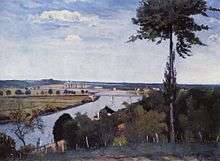Carl Fredrik Hill

Carl Fredrik Hill (31 May 1849 - 22 February 1911) was a Swedish painter.
Biography
Early life and training
Born the son of a mathematics professor, Hill grew up in the narrowness of the university town of Lund in southern Sweden and had to strike out his career as a landscape painter against his father’s will. After studying at the Stockholm Royal Academy of Fine Arts, he went to France. In the summer of 1874 Carl Fredrik Hill travelled to the village of Barbizon south of Paris, a Mecca for artists worldwide. Both the Barbizon School and Camille Corot had a decisive influence on him.
Striving for success
Hill wrote: “I have become convinced that art has no other goal than the truth, le vrai. Not the tritely naturalistic, but the true heart." He sought his subjects at different sites in France, Monitigny, Champagne and Normandy. "Ambition drives me to overexert myself and I give myself no peace" he said. Yet, Hill’s endeavors were not crowned with official success; his works were rejected when he presented them at the Paris Salon. After a severe psychotic attack and hospitalization at the age of 28, his career as a landscape painter came to an untimely end. He was diagnosed with hallucinations and paranoia. Friends helped him return home to Sweden where he gained sanctuary at his parental home after a short period at St. Lars mental hospital in Lund. At home he was cared for by his mother and a sister for 28 years until his death in 1911. In the Lund Register of deaths in 1911, he is listed as a "former landscape painter".
The second great period

During the 28 years before his death, Hill's creative work entered a new phase. As the Swedish art historian Ragnar Josephson calls it "the second great period of his life as a painter". His artistry continued unabated; during these years he drew four drawings a day.
The motifs for Hill's drawings in this period came from imagination and memory as well as from older art and illustrations. To Carl Fredrik Hill, drawing was a way to take control of the new world which had now succeeded the old one. On paper he created a world of his own. Drawing became a way to distract the evil forces that surrounded him constantly. He defended himself, using a pencil as his weapon. "The prince of whispers ... where the world glows in a blood-red struggle" writes Gunnar Ekelöf in a poem to Hill.

Hill connu? – Is Hill known?
That is what the artist wrote across a stormy sky in one of the drawings from the time of his illness in Lund. Hill never lived to see his recognition as an artist.
Carl Fredrik Hill produced thousands of drawings in various techniques: crayon, pencil, ink, India ink and watercolour. Many have been lost. Some 3,500 drawings are still thought to exist, of which more than 2,600 are part of the collections of the Malmö Art Museum, as are 23 of his oil paintings. Hill's varied subjects and styles over this period seem to have anticipated many modern movements and artists unknown to him, Henri Matisse and Pablo Picasso among them. The largest collection of all was donated to the Malmö Art Museum by Hill's heirs and have been increased with important gifts from private collections.
Carl Fredrik Hill's drawings were discovered and admired by artists mainly. Thanks to the Swedish collector Rolf de Maré, Hill's work become known in connection with the French avant-garde of the 1920s and 1930s. In 1949, a hundred years after Hill's birth, a travelling exhibition was shown in London, Luzern, Basel, Geneva and Hamburg. The exhibition was a success, and in 1952 the Tessin Institute in Paris published a book about Hill with an introduction by Jacques Lassaigne. Since then several works about Hill have appeared in Sweden, and Hill exhibitions succeed one another both in Sweden and abroad. Hill is now reckoned as one of Sweden's most important landscape painters, and the drawings done during the time he was ill in Lund have made him known outside Sweden as well.
Today his drawings continue to be a source of inspiration for both Swedish and international artists such as Arnulf Rainer, Günter Brus, Georg Baselitz, Per Kirkeby, Torsten Andersson, Ola Billgren, and Donald Baechler.
Selected works
| Wikimedia Commons has media related to Carl Fredrik Hill. |
- The Cemetery (1877) Malmö Art Museum
- Quarry with wheel tracks (1877) Malmö Art Museum
- untitled (crying dear) (1883–1911) Malmö Art Museum
- untitled (landscape) (1883–1911) Malmö Art Museum
- untitled (female with demons) (1883–1911) Malmö Art Museum
- untitled (found by the Good Samaritan) (1883–1911) Malmö Art Museum
References
- Lindhagen, Nils (1976). Carl Fredrik Hill Sjukdomsteckningarna. Malmö, Sweden: Bernces förlag.. ISBN 91-500-0274-0
- Rosdal, Anders. (2003). Hill målar. Malmö, Sweden: Malmö Art Museum. ISBN 91-87336-67-7
- Christenson, Göran (2000). Carl Fredrik Hill. Malmö, Sweden: Malmö Art Museum.. ISBN 91-630-9979-9
